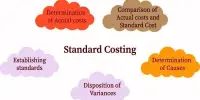The term variance refers to the deviation of actual costs from standard costs due to a variety of factors. It is the study of deviations between actual and forecasted or planned behavior in budgeting or management accounting. This is primarily concerned with how the difference between actual and planned behaviors indicates how business performance is impacted.
Variance analysis is the process of calculating and interpreting the deviation of actual costs from standards. Variance analysis assists in determining the magnitude of each variance and the causes of variance so that corrective actions can be taken.
For example, a company may forecast a certain amount of sales for the coming year and compare it to the actual amount of sales revenue received. Depending on the needs of the business, variance measurements can be performed monthly, quarterly, or yearly. The more frequently a company measures these variations, the more likely it is to find trends in its data. The type of variance analysis you perform and the predicted variances your company expects may influence whether a variance works.
For three main elements of costs, variances are to be calculated and analyzed- material, labor and overheads.
(1) Material Variance
These result from the difference between actual material costs used in production and standard material costs specified for the goods produced. This is due to the disparity between the quantities consumed and the quantities initially allocated for production. This can also occur as a result of a discrepancy between the price paid and the price budgeted for materials used. Some Common types of Material Variance –
- material cost variance
- material price variance
- material usage variance
- material mix variance
- material yield variance
(2) Labor Variance
This denotes the actual wage paid to workers as opposed to the standard wage for the output specified. When actual labor costs exceed budgeted costs, the variance is unfavorable. For example, if a company calculates variance and discovers inefficiencies or higher labor pricing, it may consider making changes for the next fiscal year. This information could help the company streamline its operations and save money. Some common types of Labor Variance –
- labor cost variance
- labor rate variance
- labor efficiency variance
- labor idle time variance
- labor mix variance
- labor yield variance
(3) Overhead variances
It is the total of all indirect material, labor, and expense costs. Overhead variances can occur when the standard overhead costs budgeted differ from the actual overheads incurred. The fixed overhead variance may assist businesses in identifying discrepancies between their budgeted overhead costs, which may be determined based on production volumes, and the number of used overhead costs.
For example, if a company wants to revisit its budget plans, it can use fixed overhead variance to determine whether it is feasible to reduce its current allotted budget. This information may assist the company in saving money or allocating funds to other areas of the business.
By monitoring planned versus actual costs, variance analysis can assist businesses in managing projects, productions, or operational expenses. Creating an effective analysis can assist businesses in maintaining and improving their operations. Calculating variance analysis is also a useful skill for businesses once the formulaic steps are understood.














